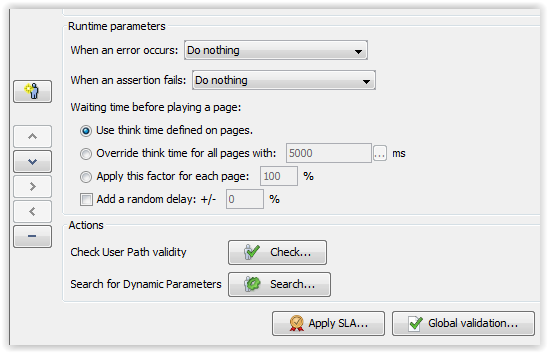Virtual User runtime parameters

Error handling
When an error occurs or an assertion fails, a Virtual User continues running by default. However, we may interrupt the Virtual User execution thread when these problems occur by forcing the user to either:
- skip to the next iteration, or
- stop and start a new Virtual User with the same profile.
The way this action is carried out depends on the Container being executed at the moment the error occurs, as described in Go to Next Iteration and Stop.
The Virtual User will not go to the next iteration if an error occurs in a Try... Catch Container. See Try ... Catch.
Think time
The think time simulates the time spent by a user on the preceding page before accessing the current page. This time delay may be set for each individual page, or globally for all pages.
- Use think time defined on pages: By default, the think time set for each page is the think time measured during recording.
- Override think time for all pages with: Use a global think time for the whole User Path. You may use a variable to obtain a dynamic behavior.
Information: With this option, the think time is not executed on the first page of the User Path, if the User Path only contains one page, the think time will not be played at all.
- Apply this factor for each page: Apply a factor to the think time used for the pages. For example, by entering a factor of 130%, you can increase the think time for the pages by 30%. A factor under 100% will reduce the pages' think time.
The Add a random delay of +/- X % option can be used to add a random element to the delay. The time delay thus obtained is between delay + x% and delay - x%.
Actions
This panel is used to access the following tasks:
- Check User Path validity. Opens the User Path checking window with the current User Path preselected. See Check a User Path.
- Search for Dynamic Parameters. Starts a search for dynamic parameters. See Frameworks.
SLA
The Apply SLA button makes it possible to link an SLA profile to the User Path. See Link a User Path element to a Service Level Agreement Profile.
Global validation
The Global validation mechanism allows setting one or more content assertions on all the responses to requests issued by the selected User Path. This means that application validation rules can be defined quickly and easily for all the User Path requests. See Global validation.